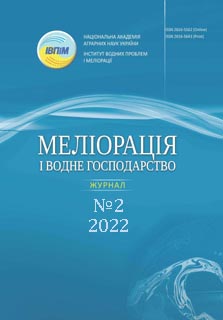INVESTIGATION OF WATER DISINFECTION PROCESSES USING PULSE ELECTRIC DISCHARGE
Abstract
As a result of Russian military aggression in the south-eastern region of Ukraine, water supply pipes and structures of centralized water supply systems were destroyed, and therefore water supply was practically stopped. The solution to the problem can be the use of mobile water treatment stations which use local sources of water: canals, lakes, ponds, or underground water. A feature of water treatment technologies in the field is the need to reliably ensure the process of water disinfection. Existing water disinfection technologies have low efficiency, taking into account the growing number of chlorine-resistant microorganisms, therefore, the implementation of alternative methods of disinfection during water treatment is urgent. One of these methods is liquid disinfection by electric current discharge. The results of the research on disinfection of different types of surface water in Kyiv and water contaminated with E. coli (Escherichia coli (E. coli)) are described. The research was carried out on a laboratory setup with a circulation pump and an ejector-type reactor with integrated electrodes where a water-air mixture is formed through which an electric discharge passes. The discharges initiate the formation of various highly reactive chemicals such as radicals (OH•, H•, O•) and molecules (H2O2, H2, O2, O3). All physical and chemical processes that occur during discharge ensure the formation and action of short-term radicals and relatively long-term oxidants. The study of the influence of the concentration of microorganisms on the speed and completeness of water disinfection was carried out on technical (tap) water with the addition of washings from two tubes with test culture to the reaction tank, which provided the initial concentration of E. coli equal to 3.4∙106 CFU/cm3. Water treatment for 30 seconds reduced the number of microorganisms to 5.4∙104 CFU/cm3. After 1 minute of treatment this indicator decreased to 1.7∙102 and after 3 minutes the value of 5.2 CFU/cm3 was recorded in the samples, that is, the treated water had indicators of practically pure water. Experiments have proven the effectiveness of plasma disinfection for liquids with high concentration of microorganisms.
References
2. Bozhko, I.V., & Charnyy, D.V. (2013). Issledovaniye effektivnosti ochistki vody ot organicheskikh primesey impulsnymi razryadami [Investigation of the efficiency of water purification from organic impurities by pulsed discharges]. Tekhníchna elektrodynamíka, 3, 81-86. [in Russian].
3. Bereka, V., Boshko, I., Kondratenko, I., & Zabulonov, Yu., Charny D. (2021). Efficiency of plasma treatment of water contaminated with persistent organic molecules. Journal of Environmental Engineering and Science, Vol. 16, Iss. 1, 40 – 47.
https://doi.org/10.1680/jenes.20.00028. [in English].
4. Bozhko, I.V., Zozulev, V.I., & Kobylchak, V.V. (2016) SOS-henerator dlya elektrorozryadnykh tekhnolohiy na osnovi impulʹsnoho barʺyernoho rozryadu [SOS generator for electrical discharge technologies based on pulsed barrier discharge]. Tekhnichna elektrodynamika. 2, 63–68. [in Ukrainian].
5. Charnyy, D.V., Matselyuk, Ye.M., & Kharchenko, M.Yu. (2016). Doslidzhennya efektyvnosti roboty kontaktnoho filtra z pinopolistyrolnym filtruvalnym zavantazhennyam pry ochyshchenni pryrodnykh poverkhnevykh vod [The study of the influence of the contact filter with polystyrene filter loading on the concentration of residual aluminum during the purification of natural surface]. Melioratsiya i vodne hospodarstvo, Vyp. 104, 26-31. [in Ukrainian].
6. Charnyy, D.V. (2016). Obhruntuvannya mozhlyvosti ochyshchennya pidzemnykh vod iz ponadnormovym vmistom Fe2++ i Mn 2+ za dopomohoyu sproshchenoyi aeratsiyi po bezreahentniy skhemi [Justification Substantiation of the treatment possibility of groundwater with an excess content of Fe2+ and Mn2+ by simplified aeration using a reagent-free scheme]. Melioratsiya i vodne hospodarstvo, Vyp.104, 48-57. [in Ukrainian].
7. Matselyuk, YE.M., Charnyy, D.V., & Levytska, V.D. (2021). Novi tekhnolohichni rishennya dlya system vodopidhotovky v suchasnykh umovakh. [New technological solutions for water treatment systems in modern conditions]. Melioratsiya i vodne hospodarstvo, 2, 201-209. https://doi.org/10.31073/mivg202102-303. [in Ukrainian].
8. Dolina, L. F. (2003). Novyye metody i oborudovaniye dlya obezzarazhivaniya stochnykh vod i prirodnykh vod. [New methods and equipment for the disinfection of wastewater and natural water]. Dnepropetrovsk : Kontinent. [in Russian].
9. Mokiyenko, A. V. (2020). Obezzarazhivaniye vody. Gigiyenicheskiye i mediko-ekologicheskiye aspekty. Tom 4: Ul'trafioletovoye oblucheniye i kombinirovannyye metody. [Disinfection of water. Hygienic and medical-ecological aspects. Volume 4: Ultraviolet irradiation and combined methods] Odessa : Feníks. 378 p. [in Russian].
10. Grudinkin ,A. P., & Piskareva, V. M. (2021). Tekhnologicheskiye i tekhnicheskiye osobennosti metoda obezzarazhivaniya vody ul'trafioletom. [Technological and technical features of the method of water disinfection by ultraviolet light]. Santekhnika, 5, 52–56. [in Russian].
11. Charnyy, D.V., Yaroshchuk, D.A., Puhach, O.V., Smirnova, H.F., Musich, O.H., Stokolos, M.O., Nikolenko, V.A., Tishchenko, I.V. & Chernova, N.M. (2021). Znezarazhennya pytnoyi vody za dopomohoyu plazmy elektrychnoho rozryadu [Disinfection of drinking water using electric discharge plasma]. Heokhimiya tekhnohenezu, 6 (34), 99 - 104. [in Ukrainian].
12. Zabulonov, Yu.L., Charnyy, D.V., Odukalets, L.A., Yaroshchuk, D.A., Puhach, O.V., Arkhypenko, O.M., & Chernova, N.M. (2021). Vyznachennya neobkhidnykh umov dlya efektyvnoho ochyshchennya pytnoyi vody z pidvyshchenym vmistom khloroformu za dopomohoyu obrobky plazmoyu v aerozoli [Determining the necessary conditions for effective purification of drinking water with an increased content of chloroform using aerosol plasma treatment]. Heokhimiya tekhnohenezu, №5 (33), 71-76. [in Ukrainian].
13. Derzhavni sanitarni normy ta pravyla «Hihiyenichni vymohy do vody pytnoyi pryznachenoyi dlya spozhyvannya lyudynoyu» (DSanPin 2.2.4-171-10). (2010). [State sanitary norms and rules "Hygienic requirements for drinking water intended for human consumption" (DSanPin 2.2.4-171-10)]. Zatv. nakazom MOZ Ukrayiny vid 12.05.2010 za № 400; za reyestr. v Minyusti Ukrayiny nakazom vid 01.07.2010 za № 452/17747. Ofitsiynyy visnyk Ukrayiny vid 16.07.2010. Kyyiv. № 51, stor. 99, stattya 1717, kod akta 51857/2010. [in Ukrainian].
14. DSTU 4808:2007 (2007). Dzherela tsentralizovanoho pytnoho vodopostachannya. Hihiyenichni ta ekolohichni vymohy shchodo yakosti vody i pravyla vybyrannya. [DSTU 4808:2007 Sources of centralized drinking water supply. Hygienic and ecological requirements for water quality and selection rules]. Kyiv. [in Ukrainian].


